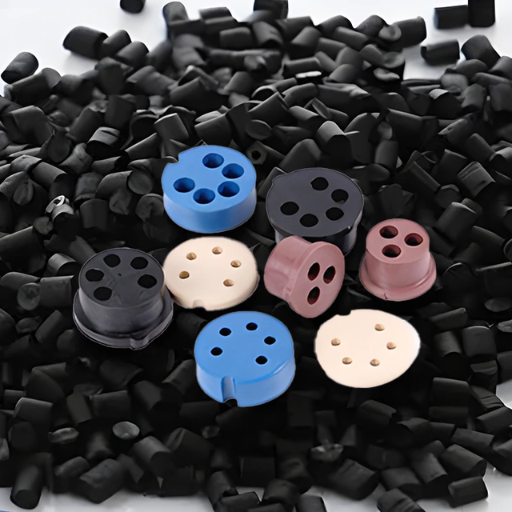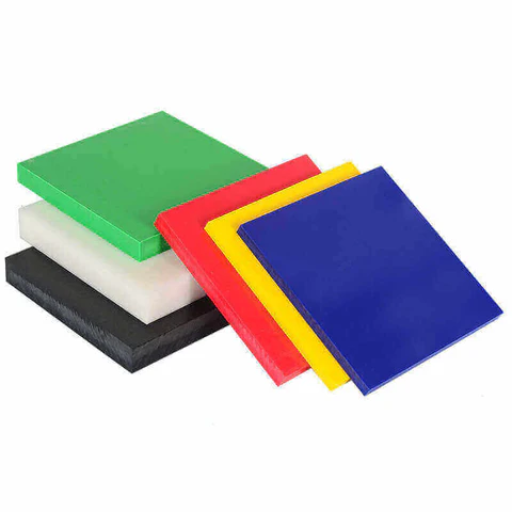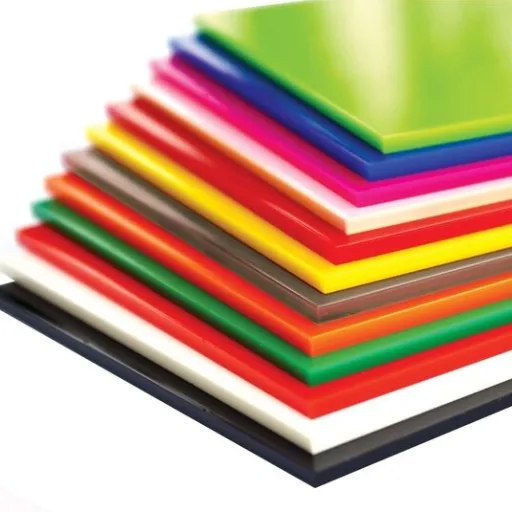Polyoxymethylene (POM), often called acetal or Delrin, is an engineering thermoplastic widely employed across industries for its strength, stiffness, and outstanding dimensional stability. However, POM’s chemical structure and composition, particularly regarding formaldehyde, raise frequent concerns for manufacturers, engineers, and consumers. POM formaldehyde raises a question: “ Is POM a Danger to its users? ” This paper simplifies POM chemistry while exploring its relationship with formaldehyde to determine if it is a concern when working with POM.
What is POM and Its Chemical Composition?

Polyoxymethylene (POM), or acetal or polyacetal, is an engineering thermoplastic widely employed for making precision components that need great strength, low friction, and outstanding dimensional stability. POM is a formaldehyde polymer that was produced from formaldehyde. It has -CH2O- repeating units, which gives it high strength and rigidity. Two main types of POM exist: homopolymer and copolymer. Each differs in characteristics owing to its molecular architecture. Homopolymer POM has greater strength and rigidity, while copolymer POM exhibits superior thermal stability and better resistance to degradation in high-temperature climates. These characteristics make POM very useful for critical industrial and consumer applications.
Understanding Polyoxymethylene Structure
POM is an engineering thermoplastic with a well-organized molecular structure. As a plastic, its molecular structure is characterized by branched chains made of CH2O that form repeating units. This specific arrangement results in high crystallinity, which can be quantified to sit between 70% and 85% based on the specific polymer and its processing conditions. Mechanical features such as tensile strength, stiffness, and wear resistance all benefit from the high crystallinity of POM.
Furthermore, the crystalline sections give greater dimensional stability, which helps POM to resist creep under high force loads even under extreme mechanical stress. This kind of stability is critical in applications with extreme precision requirements, like serving as components in gears and bearings, which must maintain strict tolerances over long periods and through several different operational conditions. Improvements on techniques for polymer synthesis and the use of specialized additives have focused on further developing the crystalline structure of POM to improve its thermal and chemical resistant properties, making it useful in a wide array of industries.
Formaldehyde in the Production of POM
Polyoxymethylene (POM) is produced mainly from formaldehyde and its derivative trioxane through polymerization processes. As a simple aldehyde, formaldehyde is important as a monomer because it is very reactive and can form a stable linear polymer with repeating CH2O monomer units. This gives POM its high crystallinity, mechanical strength, and good resistance to wear and fatigue.
Modern manufacturing techniques have overseen improvements in the polymerization processes of formaldehyde to reduce thermal degradation while improving the consistency of molecular weight. For example, the catalytic decomposition of trioxane is now widely used due to its greater efficiency in more industrial-scale production. In addition, strict protocols for removing residual formaldehyde guarantee compliance with safety regulations and environmental policies. These optimizations not only bolster POM’s mechanical and thermal properties but also widen its applicability in the automotive, aerospace, and medical sectors. Further improvements of production processes using formaldehyde continue to be important for POM developments to adapt materials, whereby permitting, compliance, and market trends justify the need.
Differences Between Homopolymer POM and Copolymer POM
In the review of the differences between homopolymer and copolymer POM, there are a few differences worth mentioning. With homopolymers, a higher average crystallinity in polymers translates to stronger tensile strength, increased stiffness, and enhanced hardness. However, it is more susceptible to thermal degradation and hydrolysis in high-moisture temperature environments. On the other hand, Copolymer POM includes comonomers that lower crystallinity, thus increasing thermal stability and chemical resistance, including moisture. This means that the copolymer variant is more advantageous in high-performance applications with varying exposure conditions. Both materials have their specific applications, and the selection is based on the mechanical and environmental needs of the intended application.
What Are the Mechanical Properties of POM?

Polyoxymethylene (POM) is a polymer with mechanical properties that make it useful in engineering processes. It is used in gears and bearings because of its low friction and resistance to wear. Moreover, POM maintains mechanical properties under varying temperatures, making it versatile and functional in different conditions. These features ensure effectiveness and reliability in harsh environments.
Exceptional Mechanical Properties of POM
POM demonstrates outstanding performance against wear and creep, which supports POM’s mechanical performance with great fatigue resistance. Insulated electrical applications also benefit from POM’s impressive dielectric properties. Hydrocarbons, solvents, weak acids, and other harsh chemicals cannot easily damage POM due to its outstanding chemical resistance, making it ideal in chemically harsh environments. POM is operational in temperatures ranging from -40 degrees Fahrenheit (-40 degrees Celsius) up to 212 degrees Fahrenheit (100 degrees Celsius), which are considered low and high temperature extremes. Thus, POM is preferred for manufacturers dealing with automotive, consumer products, and industrial goods.
Dimensional Stability and Low Friction Characteristics
POM has remarkable dimensional stability properties, and it is virtually free from distortion under mechanical stress and with environmental changes. Its low coefficient of thermal expansion ensures that parts produced out of POM maintain their shape and size with great accuracy even under temperature changes. Also, the material’s low frictional characteristics result from its self-lubricating properties that reduce wear and improve work efficiency in moving parts. These characteristics make POM very useful for systems where tight tolerances and consistent performance are required. This includes gears, bearings, and sliding devices, where preserving the part integrity while minimizing energy loss is essential for function and service life.
Comparison of Delrin and Other POM Grades
In my comparison of POM grades, one of the things I observe is that as a homopolymer, Delrin has greater strength, stiffness, and thermal stability, making it suitable for use in more demanding applications requiring higher precision. On the other hand, it could be slightly more prone to damage from chemicals or moisture than copolymer POM grades, known for their better dimensional stability and greater resistance to hydrolysis. Ultimately, the decision between Delrin and other POM grades relies on the criteria of the application, such as loading conditions, chemical exposure, and environmental conditions.
Applications of POM Plastic in Various Industries

POM plastic has extensive use across diverse industries due to its strength, dimensional stability, and low friction. Notable applications include:
- Automotive Industry: Utilized for manufacturing gears, fuel system components, and door lock systems due to its durability and wear resistance.
- Consumer Goods: Commonly used in items such as zippers, button fasteners, and appliance parts, where smooth operation and reliability are essential.
- Medical Devices: Owing to their high precision and biocompatibility, they are used in medical tools and components like inhalers and insulin pen bodies.
- Industrial Machinery: Found in conveyor belts, bearings, and pump components due to its ability to withstand repetitive motion without significant wear.
POM plastic’s properties make it versatile for applications requiring mechanical strength and precision.
Use of POM in Precision Parts Manufacturing
Due to its unparalleled strength, Polyoxymethylene (POM) is used broadly in the precision parts industry due to friction, exceptional dimensional stability, and friction. These characteristics allow the manufacture of parts with very tight tolerances, which ensures constant performance in complicated assemblies. POM is particularly useful in high-volume, low-wear industries like the automotive, medical, and industrial businesses.
For example, POM is utilized to produce fuel system components, gear mechanisms, and window lift systems in the automotive sector. These components provide consistent, durable performance under varied stressful conditions. Moreover, POM’s low water absorption and thermal resistance make it ideal for moisture—and temperature-exposed environments. Research shows that with minimal degradation over time, POM components can reduce maintenance costs by 30%.
Advanced manufacturing technologies continue to broaden the applications where they can be utilized, such as injection molding and CNC processes. With minimal post-processing required, intricate parts can be produced using injection molding. On the other hand, CNC offers high-precision fabrication. Combined with exceptional material characteristics, modern engineering for POM is available across various industries requiring precision components.
Why POM is Widely Used in Engineering Applications
The other name for polyoxymethylene (POM) is Acetal. POM is a preferred engineering thermoplastic due to its mechanical and thermal properties and resistance to certain chemicals. Regarding structure, POM possesses high tensile strength and rigidity, supporting applications that need shape retention while bearing loads. Because of its low friction and exceptional resistance to wear, POM does very well in rotating parts like gears, bearings, and conveyor parts that need to operate smoothly and last long.
Moreover, POM’s rheological consistency ensures its mechanical properties are preserved in extreme temperatures ranging from -40°C to 120°C. In addition to enhanced heat resistance, POM’s low moisture absorption guarantees reliable operation in environments with fluctuating temperatures and high humidity. POM’s exceptional resistance to a wide array of chemicals, such as fuels, solvents, and lubricants, makes it an ideal candidate for automotive and industrial parts exposed to aggressive chemicals.
With the added benefits of easy machining and molding, these attributes place POM among the most reliable and adaptable engineering thermoplastics, specially designed for advanced applications. Its cross-industry versatility, which includes advanced medical devices and heavy-duty automotive machinery, guarantees longevity and high efficiency.
Health Concerns: Does POM Release Formaldehyde Gas?

Polyoxymethylene (POM) might release formaldehyde gas under specific conditions. This usually happens during overheating, whether during the material’s processing or operation. Following proper guidelines, such as aiding airflow and keeping to appropriate temperature limits, helps reduce the chances of formaldehyde gas emission. Within boundary conditions, minimal concern is posed to approximate health issues.
Potential Risks of Formaldehyde Emission
Formaldehyde poses specific emission issues that are dangerous to health, especially with prolonged exposure to higher concentrations. It is classified by both IARC (International Agency for Research on Cancer) and NTP (National Toxicology Program) as a known human carcinogen. Increased risks an individual can develop with prolonged exposure include respiratory problems like eye, throat, and lung irritation, while worsening pre-existing asthma. Stringent safety measures are critical to control exposure in occupational settings like processing sites where polyoxymethylene (POM) is frequently used.
Moreover, thermal mistreatment of POM can lead to bypassing safe temperatures, which causes the excess release of formaldehyde vapor. Studies emphasize that high concentrations of formaldehyde, even for short periods, can lead to acute symptoms such as severe coughing, wheezing, and burning pain in the trachea. Therefore, the designated safety limits, along with sufficient measures, such as proper ventilation and temperature control while handling materials, must be put in place to avoid these risks.
Comparison with Other Plastics Regarding Formaldehyde
While assessing various types of plastics for the emission of formaldehyde, it becomes evident that one or two types have greater emission levels due to the ratio of their composition and how they are processed. For example, melamine-formaldehyde resins and urea-formaldehyde polymers are known to emit immense amounts of formaldehyde during their curing and degradation at high temperatures. At the same time, other plastics like polyethylene and polypropylene do not involve formaldehyde during their manufacturing and thus do not produce emissions, making them preferable for applications needing lower emissions.
The curing conditions and formulation additives also influence the amount of formaldehyde contained in materials made from phenol-formaldehyde resins. Unlike other thermosetting plastics, these materials are known to possess better structural stability and release formaldehyde only within a minimal range, provided specific manufacturing considerations are observed. Such nuanced performance indicates that formal assessments on the material of choice are vital for environments with strict air quality standards.
Safety Measures When Using POM Materials
When handling Polyoxymethylene (POM) materials, the potential health and environmental risks require compliance with safety protocols. POM is a thermoplastic polyacetal regarded for its high strength, stiffness, low friction coefficient, and ease of machining. However, it poses dangers when heated since it can decompose to liberate formaldehyde, volatile organic compounds associated with respiratory and other health hazards. Thus, proper ventilation is critical to prevent harmful vapor accumulation during processing, such as injection molding or extrusion.
Operators must use proper personal protective equipment (PPE) such as gloves, safety goggles, and a mask or respirator cover for exposure to dust and fumes created during the machining or thermal degradation of POM. Moreover, storage must be safeguarded since heat or sunlight may lead to material degradation. Fire prevention strategies are also essential because of POM’s combustibility; minimizing the risk of combustion by eliminating flammable materials or placing them away from high heat sources is crucial. Training and supervision provided in the workplace will help operators follow the guidelines and POM’s safety regulations.
How to Choose the Right Grade of POM for Your Project?

To best choose the grade of POM for your project needs, start by considering what specific performance characteristics will be required. Consider mechanical strength, wear resistance, and weight, among others. Then, evaluate the environmental conditions the part will face, such as temperature and chemical exposure, since these can impact POM grades differently. High-performance applications, such as lower lubricity or friction, are modified with additives for specialty grades designed for greater performance. Always review materials, data sheets, and manufacturer specifications to verify that your project’s grade is rated well. Finally, check for compliance with industry standards or regulatory guidelines relevant to your business.
Understanding Different POM Grades and Their Properties
POM, or polyoxymethylene, also known as acetal, has various grades with differing mechanical properties, such as tensile strength, impact resistance, and flexibility. Higher crystallinity in standard homopolymer grades of POM helps achieve stronger and stiffer products. On the other hand, copolymer grades provide enhanced resistance to degradation over time, especially in chemically aggressive environments. For example, homopolymers have a greater flexural modulus, frequently surpassing 2,600 MPa, enabling precision parts such as gears and bearing surface components.
Blended grades with PTFE or reinforced POM are specialty grades that offer modifications for more challenging uses. These changes can significantly reduce the coefficient of friction, which, in some formulations, can be as low as 0.1, improving wear resistance and prolonging the life of parts that move under load. Additionally, POM high-impact grades are designed to endure even greater mechanical forces without breaking, which makes them suitable for dynamic applications that require toughness.
While choosing a grade of POM, it is equally important to analyze all the mechanical property data. It is also important to look at strain under stress and fatigue, as well as other grading criteria. These parameters need to match the intended use. Manufacturers readily provide elaborate comparative data on creep resistance, hardness, and many other decisive parameters that aid in choosing the right material.
Factors to Consider When Selecting POM Material
- Mechanical Properties
The primary consideration when selecting a POM (polyoxymethylene) material is its mechanical properties. Key factors such as tensile strength, impact resistance, and stiffness must be evaluated to ensure the material can withstand the operational stresses of the intended application. Detailed stress-strain curves and fatigue data are useful for assessing long-term performance under repeated loading conditions.
- Thermal Behavior
POM offers excellent thermal stability, but different grades in heat deflection and glass transition temperatures can vary. For applications operating in fluctuating or high-temperature environments, confirm the material can maintain dimensional stability and structural integrity across the expected temperature range.
- Chemical Resistance
Assess the POM material’s resistance to chemicals such as fuels, oils, and solvents that it may be exposed to during use. Specific grades enhance chemical resistance, making them suitable for harsh environments, such as those in automotive and industrial settings.
- Wear and Friction Characteristics
Low friction and high wear resistance are hallmark properties of POM, particularly in grades designed for sliding or rotating components. Examine tribological data, such as coefficient of friction and wear rate statistics, to confirm suitability for gears, bearings, and other high-contact parts.
- Moisture Absorption
Most POM materials have low moisture absorption, but minor differences between grades can influence dimensional stability, especially in highly humid conditions. Review water absorption specifications to prevent unanticipated swelling or distortion.
- Regulatory Compliance
Depending on its intended use, ensure the POM material meets the required industry regulations, such as FDA compliance for food-grade applications or UL ratings for electrical insulation. Confirm that certifications align with regional and sector-specific standards.
- Cost and Availability
Evaluate the cost-efficiency of various POM grades while considering supply chain factors. Although enhanced grades offer superior performance, their availability and production scale may impose supply constraints or higher material costs.
Leveraging these considerations during material selection ensures optimal alignment with operational requirements and enhances POM-based components’ performance, durability, and reliability. Detailed technical datasheets and consultation with material suppliers can support precise decision-making tailored to project needs.
Applications Suited for Homopolymer vs. Copolymer POM
Homopolymer POM Applications
Homopolymer POM, known for its superior mechanical properties such as higher tensile strength, stiffness, and creep resistance, is ideal for applications with critical rigidity and dimensional stability. Specific examples include:
- Gear Components: Widely used in automotive and industrial gear systems due to their excellent wear resistance and precision machinability.
- Bearings and Bushings: Offers low friction and high resistance to wear under repeated motion, even in unlubricated environments.
- Precision Machined Parts: These are ideal for small tolerance parts like actuators and valves, benefiting from their high dimensional stability.
- Electrical Components: With its excellent electrical insulating properties, it is commonly used in plug connectors, switches, and housings.
- Automotive Fuel System Components: Exhibits superior resistance to fuels and lubricants, making it suitable for fuel pump and sensor housings.
Copolymer POM Applications
Copolymer POM is preferred for environments requiring resistance to chemicals, thermal stability, and reduced porosity. Its improved chemical and thermal resistance make it suitable for the following applications:
- Parts Exposed to Moisture or Chemicals: This type is ideal for applications like plumbing fixtures and water meter housings, where resistance to hydrolysis and chemicals is necessary.
- Food Processing Equipment: Due to its low formaldehyde emission and resistance to staining and leaching, it is frequently used in food conveyor parts and kitchen appliances.
- Mechanical Components in Harsh Environments: Used for applications like outdoor equipment gears, where excellent stability in temperature variations is crucial.
- Medical Device Parts: Approved for specific medical-grade applications, including drug delivery devices and diagnostic components, given its resistance to sterilization cycles.
- Automotive Components: Ideal for parts like seatbelt retractors and reservoirs that require excellent durability in chemically aggressive environments.
Comparative Data
|
Property |
Homopolymer POM |
Copolymer POM |
|---|---|---|
|
Tensile Strength |
Higher |
Moderate |
|
Chemical Resistance |
Moderate |
Superior |
|
Operating Temperature Range |
Narrower |
Broader |
|
Creep Resistance |
Higher |
Moderate |
|
Dimensional Stability |
Relatively Higher |
Adequate |
|
Moisture Resistance |
Lower |
Higher |
By aligning the material properties with the application requirements, engineers can make data-driven decisions when selecting between homopolymer and copolymer POM, ensuring the final product’s efficiency, reliability, and durability.
Reference Sources
-
- Published: 2022
- Key Findings: This study explored the use of propylamine to reduce formaldehyde emissions from POM during metal injection molding. The optimal concentration of propylamine (2 wt.%) reduced formaldehyde emissions by 35% while maintaining good rheological properties and green strength. The modified POM (POM-PA2) showed promise as a safer alternative for MIM applications.
- Methodology: The researchers used UV–vis spectrophotometry, FTIR, thermogravimetric analysis, and SEM to analyze the effects of propylamine on POM. They also tested the modified POM’s rheological and mechanical properties in MIM feedstock.
-
- Published: 2016
- Key Findings: This study developed a cellulose/silica hybrid material functionalized with ruthenium polyoxometalate (Ru-POM) for the catalytic oxidation of formaldehyde. The material achieved over 400 turnovers without significant activity loss, converting formaldehyde into water and carbon dioxide.
- Methodology: The hybrid material was synthesized using a sol–gel method and characterized with NMR, FTIR, UV–vis spectroscopy, and SEM. The catalytic performance was tested in a packed-bed reactor under room-temperature conditions.
-
Formaldehyde from POM brackets
- Published: 2005
- Key Findings: This study examined the release of formaldehyde from POM brackets used in orthodontics. It concluded that while POM is generally safe, variations in POM formulations or environmental conditions could influence formaldehyde emissions.
- Methodology: The study compared formaldehyde emissions from different POM formulations under controlled conditions, focusing on their safety in medical applications.
- Top POM Plastic Pellets Suppliers in China
Frequently Asked Questions
Q: Does POM contain formaldehyde?
A: Polyoxymethylene (POM), also known as acetal, is produced through the polymerization of formaldehyde. However, the final POM product typically does not contain significant free formaldehyde.
Q: What are the properties of polyoxymethylene?
A: POM exhibits excellent mechanical properties, including high strength, stiffness, and resistance to wear. These properties make it suitable for precision parts and various applications across different industries.
Q: What is the difference between POM homopolymer and POM copolymer?
A: POM homopolymer is made from a single type of monomer, resulting in better mechanical properties, while POM copolymer is made from two different monomers, which can enhance specific properties like impact resistance and processing.
Q: Can POM be used in electrical applications?
A: Yes, POM has good electrical properties, making it suitable for various electrical applications, including connectors and insulators.
Q: What are the thermal properties of POM?
A: POM exhibits excellent thermal properties, with a high melting point and stability at elevated temperatures, which allows it to be used in applications that involve heat exposure.
Q: How is Delrin POM different from other POM resins?
A: Delrin POM, produced by DuPont, is a specific brand of acetal that boasts superior mechanical and thermal properties, making it a preferred choice in demanding applications and industries.
Q: What are the risks associated with polyoxymethylene?
A: While POM is generally considered safe, there may be risks associated with working with POM, especially in inhaling dust during machining or exposure to high temperatures that may release formaldehyde.
Q: Why is POM used in precision parts?
A: POM is used in precision parts due to its excellent mechanical properties, low friction, and high dimensional stability, which are crucial for maintaining tight tolerances in manufacturing.
Q: In what industries is POM commonly used?
A: POM is widely used in various industries, including automotive, electronics, and consumer goods, due to its versatile properties and ability to meet the demands of complex applications.



